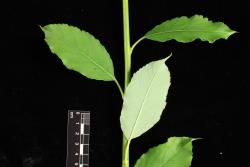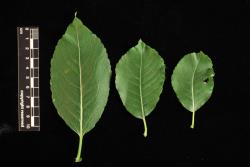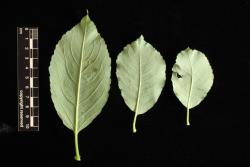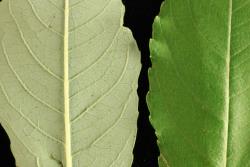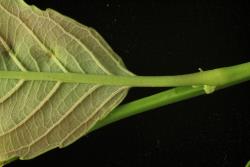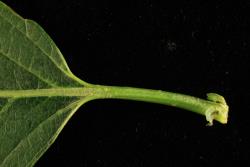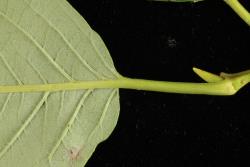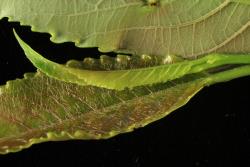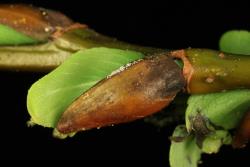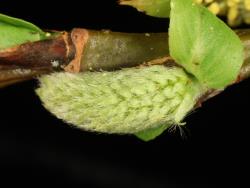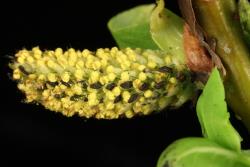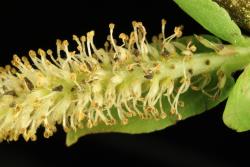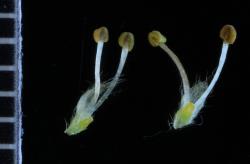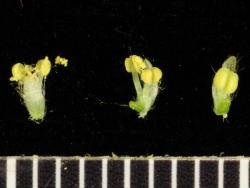Wood with sparse, short ridges. Current year's branchlets glabrous, yellow-green (UCL120). One-year-old branchlets glabrous, light olive (UCL106), 3.7–4.3 mm diameter. Flower buds 8–11 mm long, 4.5 mm wide, 3.0 mm deep, without keels, glabrous, brownish orange. Leaf buds glabrous, very similar in size and shape to flower buds. Leaves alternate, not falcate. Stipule 2–5 mm long, falcate, asymmetrically narrowly ovate, not persisting. Petiole 20–26 mm long, lamina decurrent on the petiole, glabrous, glands absent, base not enlarged. Emerging leaves tinged with orange, with sparse long-silky hairs. Proximal leaves crenate. Leaf lamina 96–125 mm long, 42–64 mm wide, length to width ratio 2.0–2.3:1, elliptical; base cuneate; apex acuminate; leaf galls absent; margins serrate, undulate, finely revolute or flat; upper lamina surface slightly bullate due to impressed veins, dull to slightly glossy, glabrous except a few long-silky hairs on the midvein, stomata absent; lower lamina surface midvein and side-veins raised, netted veins visible, distinctly glaucous, glabrous. Catkins emerging coetaneously with leaves. Flowering branch 32 mm long, with 3 leaves or a mix of leaves and cataphylls. Male catkin 17–27 mm long, 6–7 mm diameter; catkin rachis visible or not between flowers. Flower bract 1.9–2.6 mm long, 0.6–0.9 mm wide, pale yellow-green with a slight reddish tint present at the apex and upper margins before flowering, slightly channelled and incurved towards the apex; apex acute, covered in moderately dense long-silky hairs. Male nectary 1, 0.6–0.7 mm long, 0.36–0.50 mm wide, yellow to brownish yellow-green. Stamens 2, filaments free, filament hairs very few and at base only; anthers 0.6–0.8 mm long, yellow.
Unusual in the shrub willows in having the flowering bract hyaline yellow-green rather than turning black distally (a feature shared with S. eleagnos, S. exigua, S. repens, and S. triandra), but on a single catkin this varies: most bracts stay yellow-green while others turn black distally and may do so before anthers dehisce. Leaves are elliptical, thin and soft in texture, margins undulate and serrated, finely revolute; both surfaces are glabrous in mature leaves (but emerging leaves are sparsely long-silky hairy and hairs may persist on the upper surface midvein). The upper surface is slightly bullate and stomata are absent. The lower surface is distinctly glaucous, with side-veins raised and prominent at the lamina base. The lamina is decurrent on the petiole. The leaves of PN688 are exceptionally large for Salix reinii, with a lamina 102–130 mm × 45–64 mm (cf. 10–90 mm × 10–50 mm).
Most similar to Salix apennina and S. myricoides in leaf size, shape, and softness, and absence of hairs in mature leaves. Salix reinii has only males present in New Zealand, as has S. apennina, while both male and female plants of S. myricoides are present. Salix reinii is inconsistent in flower bracts turning black, whereas in S. apennina all flower bracts turn black distally.
In cultivation in Southern North Island (Aokautere and Massey).
First collection: CHR 649568, D. Glenny, L. Newstrom-Lloyd, T. Jones, 12 September 2017, Aokautere.
First publication: This publication.
Flowering: Late September–early October.
Tetraploid, 2n = 76 (CCDB, based on a single count), provisionally confirmed using flow cytometry of PN688, but Ohashi (2006) reported a chromosome number of 2n = 152.



